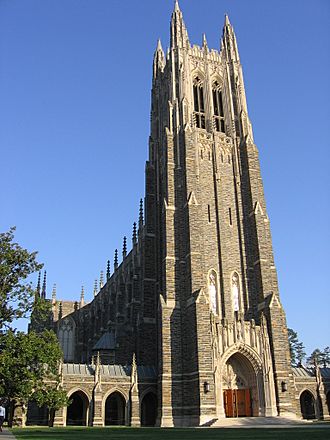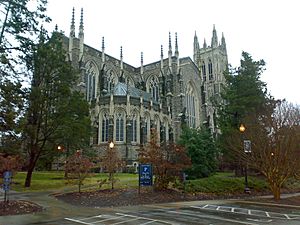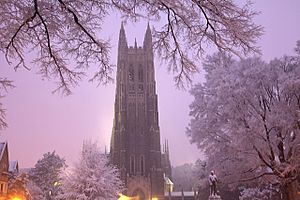Duke Chapel facts for kids
Quick facts for kids Duke Chapel |
|
|---|---|
 |
|
| General information | |
| Type | Center of Duke's Campus |
| Architectural style | Collegiate Gothic |
| Location | West Campus, Duke University |
| Coordinates | 36°0′5.99″N 78°56′23.32″W / 36.0016639°N 78.9398111°W |
| Completed | 1935 |
| Cost | US$2.3 million |
| Design and construction | |
| Architect | Julian Abele and Horace Trumbauer |
| Other information | |
| Seating capacity | 1800 |
Duke University Chapel is a beautiful chapel found right in the middle of Duke University in Durham, North Carolina. It's a special place for people of all Christian faiths, and it's also connected to the United Methodist Church.
The chapel was finished in 1935. It can hold about 1,800 people. It stands 210 feet (64 meters) tall, making it one of the tallest buildings in Durham County. The chapel is built in a style called Collegiate Gothic. This style uses large stones, pointed arches, and ribbed ceilings. Inside, it has a 50-bell carillon and three large pipe organs. One organ has 5,033 pipes, and another has 6,900 pipes!
The chapel sits on the highest part of Duke University's West Campus. Plans for the chapel started in 1925, but building began in 1930. It cost $2.3 million to build. The chapel was the last of the main buildings to be finished on West Campus. It was first used for graduation in 1932, even though it was still being built. It was officially finished and opened on June 2, 1935. The beautiful stained-glass windows were added later.
The chapel was designed by Julian Abele. He was a famous African-American architect who designed many buildings on Duke's West Campus. He worked for the firm of Horace Trumbauer. As of 2025, the head of the chapel is Rev. Luke A. Powery. The chapel closed for a year in 2015 for important repairs to its ceiling. It reopened on May 11, 2016.
Contents
Outside the Chapel
Main Entrance
The chapel's main entrance has detailed carvings of ten important figures. These figures are important to Methodism, Protestantism, and the American South.
On the outer arch, you can see three leaders of the American Methodist movement:
- Bishop Francis Asbury in the middle.
- Bishop Thomas Coke on the left.
- George Whitefield on the right.
On the left wall inside the entrance, there are carvings of:
On the right wall, you'll find:
- Thomas Jefferson, a statesman from the South.
- Robert E. Lee, a soldier from the South.
- Sidney Lanier, a poet from the South.
John Wesley, who started Methodism, is carved above the chapel doors. These carvings were made by workers from the John Donnelly company.
In August 2017, the statue of Robert E. Lee was damaged. This happened during protests across the United States about Confederate memorials. Duke University decided to remove the statue. The university announced that the space would remain empty. This empty space is meant to remind people of this moment in history.
Bell Tower
The bell tower of Duke Chapel looks like the Bell Harry Tower at Canterbury Cathedral. It is 210 feet (64 meters) tall and 38 feet (12 meters) wide at its base. Most of the tower is built from stone from the Duke Quarry. The top parts are made of limestone from Indiana.
Inside the tower is a 50-bell carillon. This was a gift from The Duke Endowment. The heaviest bell weighs 11,200 pounds, and the lightest weighs only 10.5 pounds. There's an elevator and a winding staircase with 239 steps to reach the top. The bell tower is not usually open to the public. Duke University students can visit it at special times during orientation and graduation.
Inside the Chapel
Duke Chapel is shaped like a cross, which is common for many Christian churches. The main part, called the nave, is 291 feet (89 meters) long, 63 feet (19 meters) wide, and 73 feet (22 meters) high. The walls and ceilings are made of special Guastavino tile. This tile was sealed in 1976 to make the sound of the organ even better. The chapel also has a Memorial Chapel and a crypt.
Stained-Glass Windows
The chapel has 77 beautiful windows. They were designed and made over three years by 15 artists. They used over one million pieces of glass from England, France, and Belgium. The glass pieces are about 1/8 to 3/16 inch thick. The largest window is 17.5 by 38 feet (5.3 by 12 meters). The smallest is 14 by 20 inches (360 by 510 millimeters).
The windows show scenes and people from the Bible. Many of the figures are larger than life-size. The big windows high up along the nave show scenes from the Old Testament. The smaller windows along the sides of the nave show scenes from the New Testament. Both Old and New Testament images are in the two large transept windows and the altar window. The windows near the entrance show women from the Old Testament. Small windows in the entrance halls show six scenes from the life of Jesus. The windows in the Memorial Chapel are silver-tinted. Those in the crypt are purple glass with lead frames.
Chancel Area
The chancel is the area at the front of Duke Chapel. It holds the altar, the choir stalls, the pulpit, and the lectern. You can see carvings of Patriarchs, apostles, saints, and other religious figures. These are carved from limewood and oak. They appear in the choir stalls and behind the altar. Scenes from the Passion (events leading to Jesus's crucifixion) are carved into the north and south walls of the chancel.
Organs
Duke Chapel has three large pipe organs. Each one is built in a different style. They are used for church services, special events, concerts, and for students to learn how to play the organ. The chapel also has a small, portable "box" organ for smaller groups.
The Kathleen McClendon Organ is the chapel's first organ. It is hidden behind oak screens on both sides of the chancel. It was built in 1932. This organ has 6,900 pipes. It can make many different sounds. It was fully repaired in 2009.
The Benjamin N. Duke Memorial Organ was added in 1976. It was built by a Dutch company in the style of 18th-century Dutch and French organs. It is located near the main entrance. This organ has 5,033 pipes. Its main case, which holds most of the pipes, is made of solid mahogany. It is decorated with colors and gold leaf. The case is 40 feet (12 meters) tall.
The Brombaugh Organ was installed in 1997. It is in a special "swallow's nest" gallery in the Memorial Chapel. This organ has 960 pipes. It is made in the style of Renaissance Italian instruments. It makes a soft, clear sound. The Duke family crest is at the top of this organ.
Memorial Chapel
A Memorial Chapel was added to the left side of the main chapel. It was built by the Duke Memorial Association. This chapel is a quiet place for thinking and prayer. It is open to visitors and separated by large iron gates.
Along the left wall, you'll find the tombs of the university's supporters. These include Washington Duke and his two sons, James B. Duke and Benjamin N. Duke. Their tombs are made of 30-ton white Carrara marble. They were carved by Charles Keck. Above the altar are three limewood figures: Jesus in the center, with St. Paul on the left and St. Peter on the right. The Duke family coat of arms is carved into the ceiling.
Crypt
Many important people from Duke University are buried in the crypt. This is a special burial place directly under the Memorial Chapel. These include three past presidents of the university:
- William Preston Few (1924–1940)
- Julian Deryl Hart (1960–1963) and his wife Mary Johnson Hart
- Terry Sanford (1969–1985) and his wife Margaret Rose Sanford
James B. Duke's wife, Nanaline Holt Duke, is also buried here. Other people buried in the crypt include James A. Thomas, who led the Duke Memorial Association, and James T. Cleland, a former Dean of Duke Chapel, with his wife Alice Mead Cleland. Two plaques on the crypt walls remember university presidents Arthur Hollis Edens (1949–1960) and Robert Lee Flowers (1941–1948).
Chapel Size
At 210 feet (64 meters) tall, Duke University Chapel is one of the tallest university chapels in the world. It is similar in height to the Basilica of the Sacred Heart at Notre Dame, which is 218 feet (66 meters) tall.
Statue Removal
On August 16 and 17, 2017, the statue of Robert E. Lee at the chapel's entrance was damaged. This happened after protests about Confederate memorials across the United States. The statue's face was chipped. A week later, Duke University president Vincent Price approved the statue's removal. He said the statue would be kept so students could learn about Duke's past. As of 2025, the space where the statue was remains empty.
See also
- Collegiate Gothic
- Gothic Revival architecture





